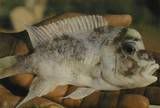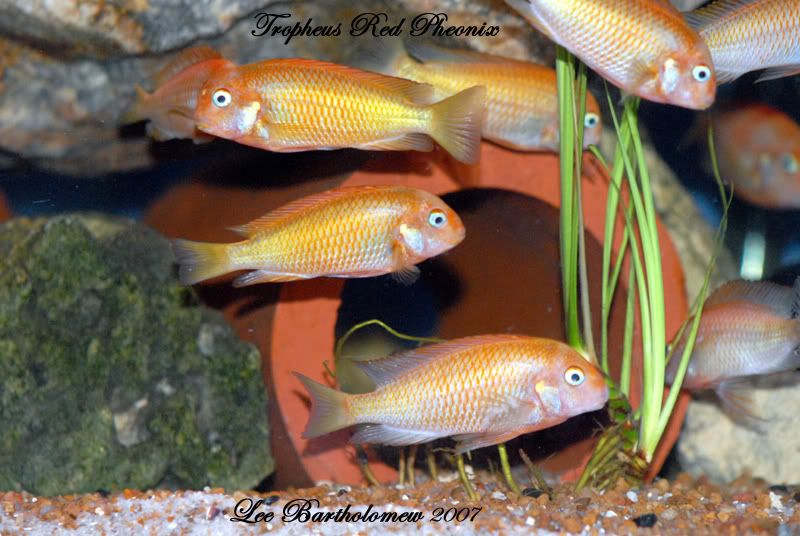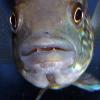Marbled Peacocks - Hybrids? Evidence = Probably Not
#41

Posted 15 June 2011 - 06:28 PM
#42

Posted 15 June 2011 - 06:35 PM
#43

Posted 15 June 2011 - 06:39 PM
Awesome find Gibbs!
I had not seen that one!
#44

Posted 20 June 2011 - 08:04 PM
Unfortunately the marbled peacock is a hybrid between an Aulonocara stuartgranti and an OB Metriaclima zebra; no doubt about it being a hybrid.
Best regards and enjoy your cichlids!
Ad
I am placing this issue on the next C/M agenda given this new information.
I am also asking for any comment from members who think this is disputable or would like to challenge Ad’s information to put their comments forward
#45

Posted 20 June 2011 - 09:36 PM
he also alluded to a point that some genetic studies were done on one locality of peacock and they did not find the gene responsible for Marbling.... Im sure that there are one or two peacocks out there that carry this very rare trait - but you have to find it first.... and no tests have been done to compare the genes of the marbles and other peacocks and compare them to Zebras - and have tests been done to see if Tangs that occasionally show Marbling actually have this gene? not yet to my knowledge...
Looking at the number of marbled species known to exist but rarely if ever seen in Tanganyika and those of Lake Victoria, and also in central America..... and considering the marbled variants of cichlid species like Angels available in captivity, but never will be seen in the Amazon, why cant a marbled peacock ever evolve from inbreeding??? The possibility is there with every living thing (eg, reptiles and birds show leucistic genes - but only in captivity) Purists only want to breed known type localities - and fair enough, I'd like to be with them too - but dont push your barrow to win a race by pushing over someone else's..... let's not be racist and leave the poor leucistic fish alone to their nice colours....
#46

Posted 20 June 2011 - 09:36 PM
#47

Posted 20 June 2011 - 09:38 PM
 ?
?
#48

Posted 20 June 2011 - 10:07 PM
That I think should be an interesting read when weighing into this debate. I would post it here but I am not allowed to link to Oz Fish For Sale
It concernes collection divers from both lakes Malawi and Tanganyika and comfirmed instances of them pulling and exporting OB, Albino and leucistic specimens from the lake.
I think this should be included here if allowed....
Unfortunately the originating site (tanganyika-cichlids.com) is down, so links to it will not work.... but here is the bulk of it...
Here is the translation:
it is taken from here:http://tanganyika-cichlids.com/ob_et_autres_bizareries.htm
OB and other oddities

Tropheus moorii Kalambo OB Tropheus moorii Kalambo OB
By Eric Genevelle
OB cichlids in Lake Tanganyika? Mr. Genevelle Z'avez smoked!
Nope, there exists. Certainly, it is incommensurate with the lakes Malawi and Victoria, but the examples are numerous. We can not say that there are entire populations of OB cichlid in Lake Tanganyika, but isolated individuals who exhibit this surprising particularism.
Not long ago, I knew the only form of OB Tropheus moorii Kalambo (aka Golden Kalambo). Toby Veal had a superb article in one of Cichlid Year Book. He related well to have some fifty specimens collected in southern Kalambo and a breeding program to select individuals carrying this recessive genetic trait was developed. Today we know that this program (presumably experienced in greenhouses Laif Demason Florida) has not had the expected success (too much work for a very small number of individuals OB). Some specimens have still gone on sale ....

To the question "Why is he has the shape of this character that Kalambo OB?", The answer is given by African Diving : "We find this kind of scarcity in the lake quite often, such varieties OB at all and many Tropheus Petrochromis, and once a female Ophthalmotilapia nasuta Gold Kipili. A year ago, and half of that, we collected a Petrochromis trewavasae to Lunangwa was completely yellow, etc., etc. "
These sayings on varité OB on Tropheus is reinforced by the fact that exporter offers on its inventory list different breeds OB (mostly female) Tropheus:
- [li]
Tropheus sp. Tropheus sp. "Kushangaza", 1 MC-male+3 OB-females "Kushangaza", 1 MC-3 male-female OB[/li]
[li]Tropheus sp. Tropheus sp. "Red cheek - Cape Mpimbwe", OB-female "Red cheek - Cape Mpimbwe," OB-female
[/li]
African Diving also collected in May 1999 Cyprichromis leptosoma OB Utinta.Upon inquiry, it was an isolated specimen. This fish was exported to the U.S. and photographed by Ken Armke .

Outside the OB forms, there are also natural forms to various recessive traits such as a leucistic lack of pigments (as in this Cyphotilapia frontosa photographed by Ad Konings ) or complete albinism (F1 Tropheus brichardi Kipili from among Fishes of Burundi). It is clear that if these forms exist in nature, their life expectancy is very low. Indeed, it will not be recognized by their peers as conspecific hence the immense difficulty to reproduce and because of their color pattern is not suitable, they are the favorite prey of any passing predator range of teeth.


Tanganyika Cichlids Tanganyika Cichlids
http://tanganyika-cichlids.com http://tanganyika-cichlids.com
Eric Genevelle
Edited by Mr_docfish, 20 June 2011 - 11:24 PM.
#49

Posted 20 June 2011 - 10:14 PM
#50

Posted 20 June 2011 - 10:40 PM
I am looking though the powers of deduction, not assumption.... no doubt a similar fish could be created crossing the two - but how difficult is it to obtain a tangerine peacock from a marble peacock (they were available at around the same time) has anyone happened to get a tangerine zebra from a OB zebra before?.... If a peacock got he OB genes from a OB Mbuna, then how did the tangerine peacock appear at around the same time? Is it because someone else crosses a Tangerine Zebra with another peacock? and did someone else cross an albino zebra with a different peacock again?.... or wait a minute... did someone get an albino peacock, really, and cross it with all the different Mbuna to get all the different albino Mbuna we have now? lol... how much fun I can have with these.... start a few threads around the world, and eventually it will end up on Wiki, and if lucky, on Fishbase....
Ad names a Pseudotropheus socollofi in his books, but fails to mention what Stuart Grant has admitted - that he (Stuart) had let loose a Mbuna from another locality, and it hybridised with a local species creating this new species..... so if it occurs in the lake, it is fine? should let a few peacocks lose in there huh?
Look at this fish -

information on it is here:
http://www.cichlidne...t/whatsnew.html
"This aquarium morph produced in Burundi from a Tropheus sp. Karambe has a pink colored body similar to an albino form but lacks red eyes. With the strong red coloration suffused throughout the body, this rare strain is called Red Bishop and should be a hit with Tropheus fans. " Laif DeMason
but read what is written here by forum nuts... and then read the last post on page 2.....:
http://www.cichlid-f...p...&highlight=
as you can see..... total hogwash gets written by all sorts of people..... but when the truth comes out, they all fall silent....
Edited by Mr_docfish, 20 June 2011 - 10:42 PM.
#51

Posted 20 June 2011 - 11:04 PM
http://www.cichlidae...ticle.php?id=23
Note this comment:
"These cichlids differ significantly from the P. fenestratus found throughout the Papaloapan drainage. The Catemaco forms presumably evolved from the riverine type following a period of isolation resulting from the creation of the volcanic crater."
This is an example of inbreeding in the wild - creating a smaller gene pool, allowing these odd colourations to occur.... now compare this to the aquarium - even greater limitation of the gene pool..... given that nearly all species of animals can produce leucistc sports, the chances of creating a leucistic strain in a peacock in this aquarium environment is very great.... particularly in Australia with our restricted imports and small population or fish keepers.
#52

Posted 20 June 2011 - 11:14 PM
Originally caught below the Owens Dam near Jinga (Uganda) and now available from breeders, this “Haplochromis” sp. “red-fin piebald” is a male; females can be red-orange in body coloration.

#53

Posted 21 June 2011 - 09:15 AM
of Aulonocara as they have today .Talk to the florida fish farm guys they know what they crossed to get them
as certainly Ad does.
#54

Posted 21 June 2011 - 09:39 AM
Unfortunately the originating site (tanganyika-cichlids.com) is down, so links to it will not work.... but here is the bulk of it...
Have any of you consulted with Norm Halliwell? He is our countries fore-most expert on malawi's and his take is a little different...
Here is what he has to say on the matter, this is a link to a post by him on Auscichlids so I do not know if me posting it here will work.
http://auscichlids.c...hp?topic=3637.0
Edited by Hood, 21 June 2011 - 03:38 PM.
#55

Posted 21 June 2011 - 09:51 AM
That I think should be an interesting read when weighing into this debate. I would post it here but I am not allowed to link to Oz Fish For Sale
Your previous post. You said you would post it here but are not allowed. It appears Oli saved you the hastle.
He saved the images to his photobucket account.
#56

Posted 21 June 2011 - 10:08 AM
Edited by Hood, 21 June 2011 - 03:36 PM.
#57

Posted 21 June 2011 - 10:25 AM
Different industry experts have different theories.
No one is 100% sure.
Even if this fish in not a cross with a Metriaclima, there is no way to be sure that it is entirely A stuartgranti and not a mix of other Aulonacara.
And hybrids are against the constitution.
I dont believe I am doing the hobby in this country a dis-service. I would love, nothing more, than to be able to walk into any lfs and buy a A stuartgranti and know for sure that it is entirely A stuartgranti. But we dont. And alot of people refuse to buy any peacocks simply because of the cross breeding problems with them in this country.
Even now that they can be imported, people still dont trust them. How many times have you walked into an lfs and seen a tank labeled "Various Peacocks"
What exactly is at stake here?
Perhaps banning these fish from import, and the introduction of iridiovirus testing, will just mean that local breeders will be able to raise some fish up to 3 cm and sell them for enough money to make it worthwhile to do so.
In doing so, more effort will be placed on further colour enhancing through line breeding.
#58

Posted 21 June 2011 - 10:35 AM
Edited by Hood, 21 June 2011 - 08:01 PM.
#59

Posted 21 June 2011 - 11:01 AM
I did send an email to a number of people asking for input including Norm who's reply did point to the lineage of Tangerine and Dragon bloods, but not the Marbled, only suggesting that even if it was a hybrid it is now entrenched in the hobby:
Ad Konnings also commented on Dragon bloods and tanergine peacocks ( Both local trade names) I did include this on the debate on these fish but not here as we were only talking about Marbled peacocks:
Cheers,
Ad
#60

Posted 21 June 2011 - 12:11 PM
I understand he makes this statement...but where is the supporting evidence? With every other instance he sites an example, however he gives none with the OB, just his oppinion of the 2 species used.
Edited by Hood, 21 June 2011 - 04:19 PM.
0 user(s) are reading this topic
0 members, 0 guests, 0 anonymous users












